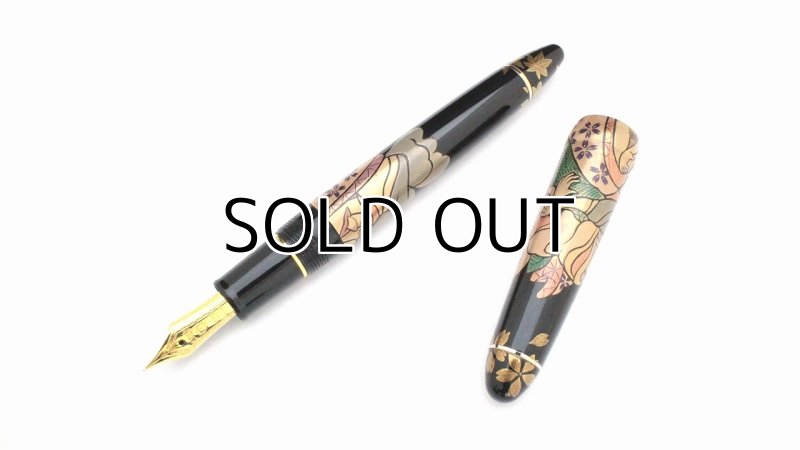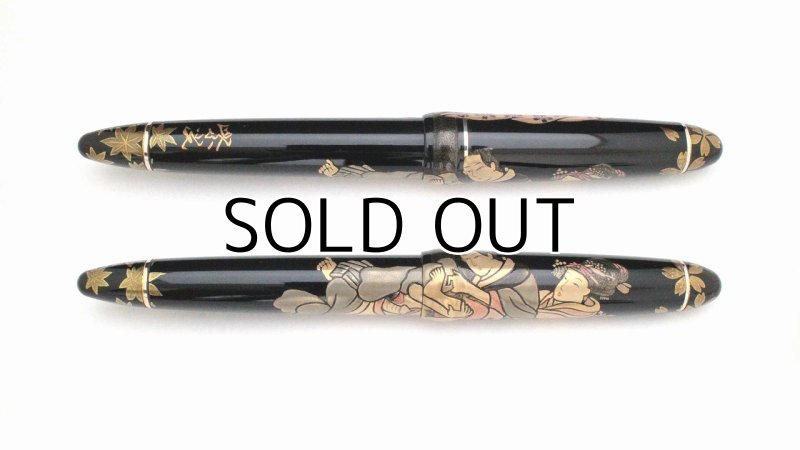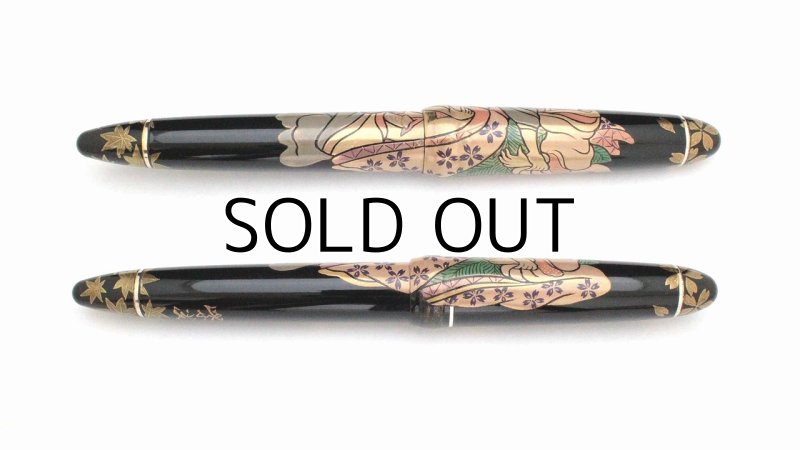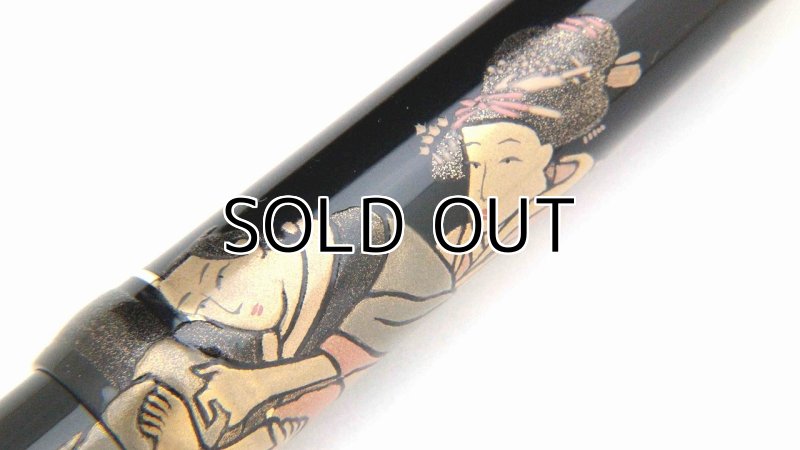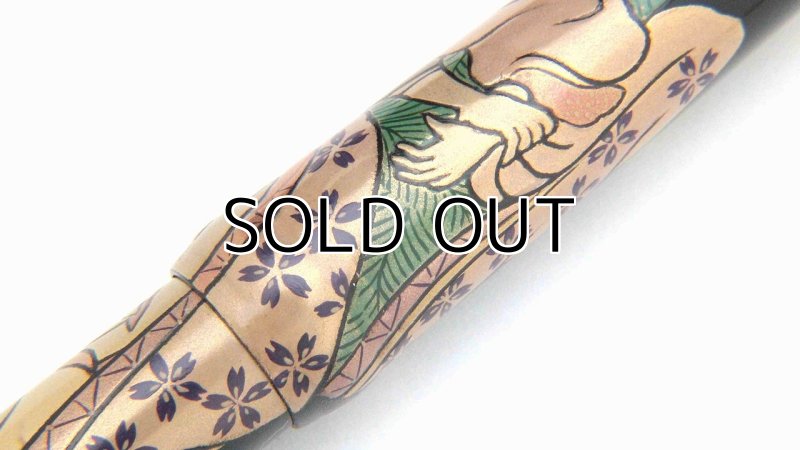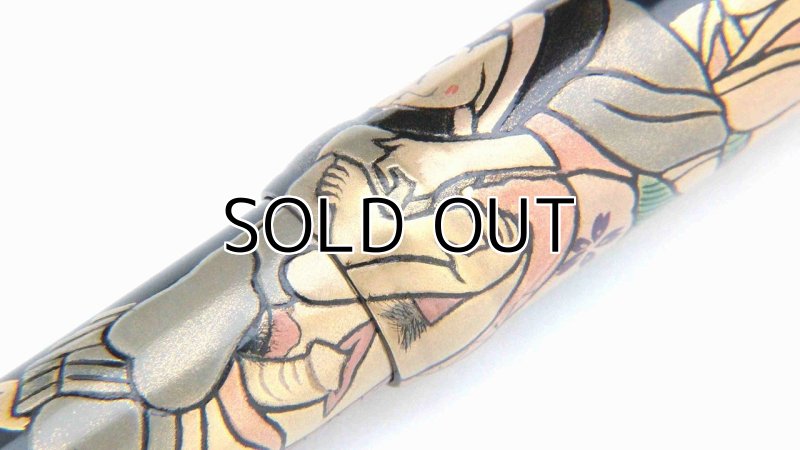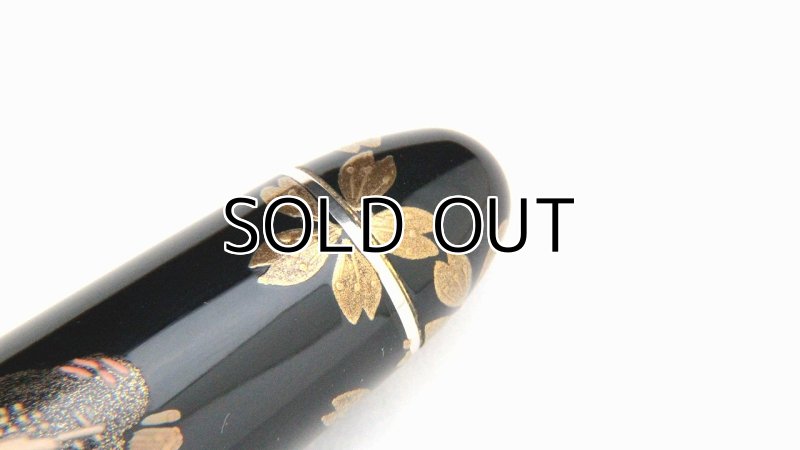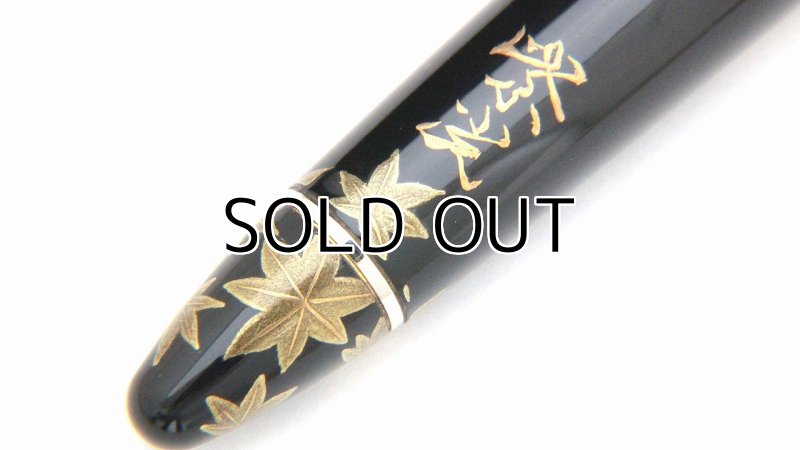AGJ Original Maki-e Fountain pen "Ukiyo-e Shuga" Sailor 21K nib
AGJ Original Maki-e Fountain pen "Ukiyo-e Shuga" Sailor 21K nib
Our Selling Price: US$2,000.00(tax excluded)
Item Description
This AGJ original Maki-e Fountain pen is made by famous Kyoto Maki-e Artisan "Daikai".
This design is an AGJ's original. You can not find anywhere else.
Kyoto Maki-e is the best known Maki-e technique in Japan.
This is original Maki-e fountain pen based on Sailor fountain pen.
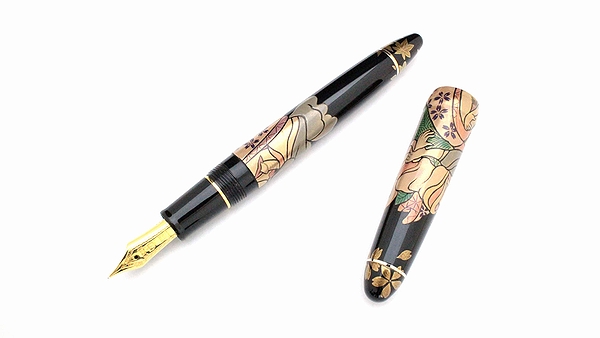
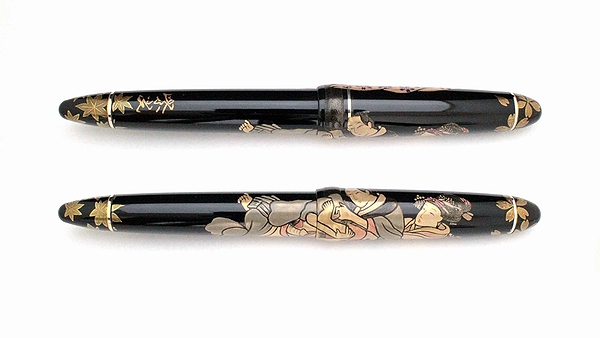
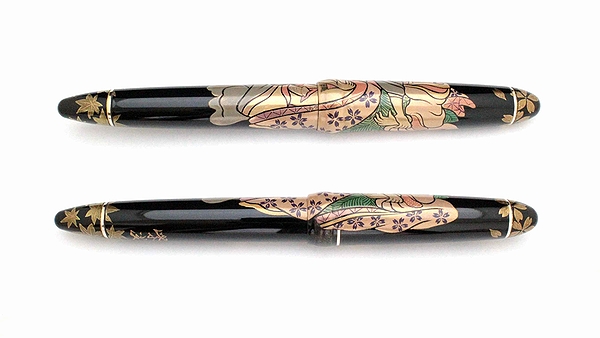
In all designs, Taka Maki-e lacquer are piled up for Taka Maki-e on top of the raised silver powder.
Repeat it twice.
Sprinkle gold powder #9
To prevent the powder from flying off, stick it with colored urushi lacquer.
Then, scrape with charcoal the colored lacquer applied on the whole surface, and polish it to make the gold powder appear.
Kimono designs are painted by colored urushi.
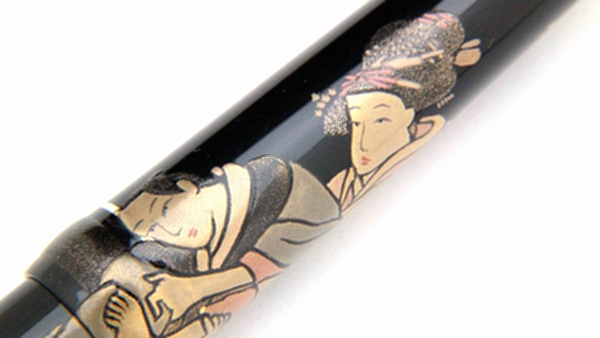
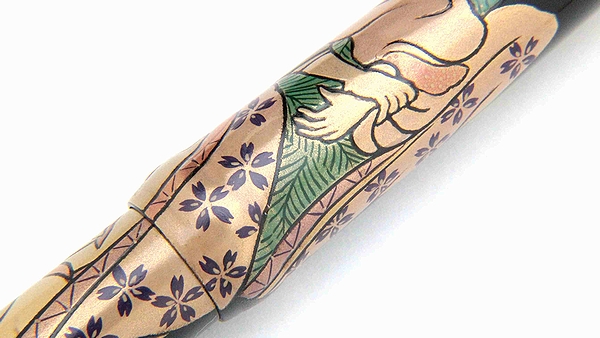
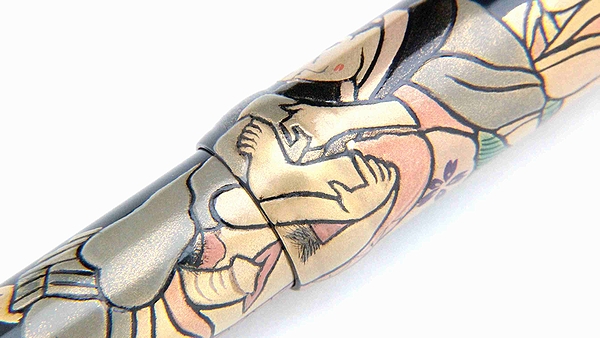
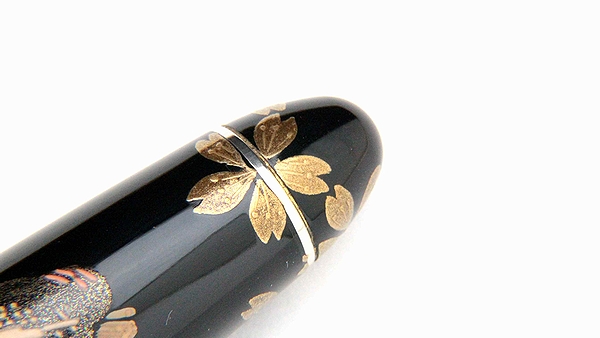
Cherry blossom Petals: Hira Maki-e
Gold powder
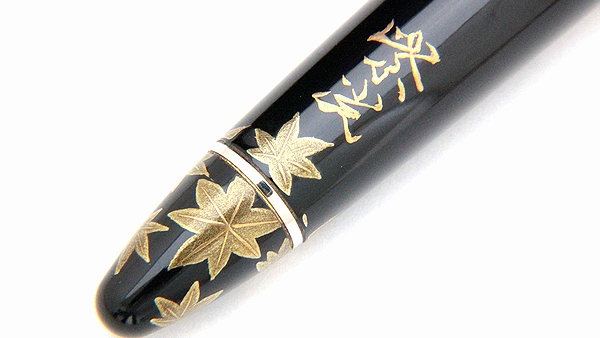
Maple: Hira Maki-e
Gold powder
This design is an AGJ's original. You can not find anywhere else.
Kyoto Maki-e is the best known Maki-e technique in Japan.
This is original Maki-e fountain pen based on Sailor fountain pen.



In all designs, Taka Maki-e lacquer are piled up for Taka Maki-e on top of the raised silver powder.
Repeat it twice.
Sprinkle gold powder #9
To prevent the powder from flying off, stick it with colored urushi lacquer.
Then, scrape with charcoal the colored lacquer applied on the whole surface, and polish it to make the gold powder appear.
Kimono designs are painted by colored urushi.




Cherry blossom Petals: Hira Maki-e
Gold powder

Maple: Hira Maki-e
Gold powder
[What is Maki-e technique?]
-
Hira Maki-e
- Urushi lacquer
- Sprinkle Gold powder, Seikin: Alloy of Gold, Silver powder, Hirame and so on
- Coated by Uwazuri and Black urushi
- Polish by polishing and grindstone powders
-
Togidashi Maki-e (Mainly used for finishing evenly the background)
- Urushi lacquer
- Sprinkle Gold powder, Seikin: Alloy of Gold, Silver powder, Hirame and so on
- Coated thickly by Nashiji and Black urushi
- Burnished the urushi lacquer by charcoal
- Polish by polishing and grindstone powders
- When coarse gold/silver/Hirame/Seikin powders are sprinkled, put a luster by burnished.
- After togidashi maki-e, Togidashi Hira maki-e is decorated Hira maki-e on togidashi maki-e.
- After togidashi maki-e, Togidashi Taka maki-e is decorated Taka maki-e on togidashi maki-e.
- Burnishing is needed when coarse powders are sprinkled.
-
Taka Maki-e
- The design is created using urushi lacquer
- Sprinkle charcoal/Silver powders to raise the layer
- Dry
- Spread urushi twice to make the layer thicker
- Sprinkle gold/silver/Hirame/Seikin powders
- Coat by Urushi
- Burnish
- Polish
- Charcoal powder: Show a soft feeling
- Silver powder: Feel solid
-
Tsukegaki Maki-e
- Spread Urushi lacquer thickly
- Sprinkle gold powder
- Gold powders sink due to thick urushi
- Do Togidashi
- Gold powders shine
- Polish
[Description]
| Name: | Ukiyo-e Shuga |
| Maki-e Artist: | Daikai |
| Technique: | Taka Maki-e |
| Origin: | Kyoto, Japan |
| Nib: | 21K Gold with 24K Gold plating |
| Nib size: | Medium (If you prefer a broad nib, please let us know.) |
| Size: | 15.7mm(Dia.) x 149mm |
| weight: | 27g |
| Shipping: | FREE SHIPPING! |
| Others: | AGJ Original Design Maki-e |
[Daikai's Career]
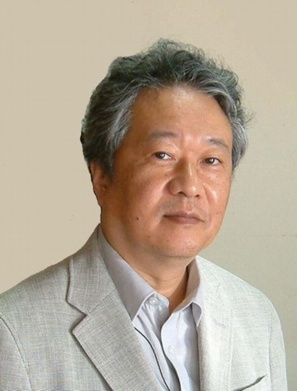
| Year 1950 | Born in Kyoto His father, uncle, grand father and grand-grand father were Urushi Lacquer masters too. |
| 1969 | Another Urushi artist "Masakichi Shima" started teaching Daikai. |
| 1976 | Daikai began succeeding to inherit the style of Kyoto Makie (Maki-e). |
| 1985 | Won the Kyoto Chamber of Commerce Award at Kyoto Lacquerware exhibition. |
| 1986 | Held Urushi Lacquer exhibition at Kyoto Takashimaya (the largest department store in Japan). |
| 1990 | Exhibited at the Arts and Crafts in kyoto. |
| 1991 | Became a technical lecturer for the artists at the traditional industry at Kyoto. |
| 1994 | Opened his Kyoto Urushi lacquer school. |
| 1995 | Invited to display his works at INFA 1995 in Hannover, Germany. |
| 1997 | Won the award at the industrial techniques for the crafts in Kyoto. |
| 1999 | Held the first Kyoto Urushi lacquer school’s exhibition at Ko-dai temple, Kyoto. |
| 2001 | He has held the traditional crafts exhibition every year since 2001. |
| 2008 | Held Amber Maki-e and Lacquer works exhibition at Sogo department store. |
| 2009 | Held Kyoto Urushi Lacquer exhibition at Takashimaya in Namba, Osaka. |
He lives in Kyoto now and teaches many Maki-e artisans Kyoto-Makie technique. |
